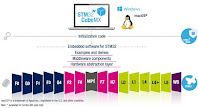 There's a lot of information out there on using MCU's like arduino or more upscale M4 arm-cortex chips like those manufactured by STM as a process controller.
There's a lot of information out there on using MCU's like arduino or more upscale M4 arm-cortex chips like those manufactured by STM as a process controller.Measuring stuff // Controlling stuff.
Just google STM32F4 and you will find all kind of howto's on how to manage i2c or spi data streams.
We as audio engineers being only interested in i2s are not that lucky.
Don't get confused by i2c versus i2s!
Also there is references for i2c and AD/DA but this will be about analog sensor data. Not Audio!
So, as a future reference, I am going to describe the long and arduous task of getting these things to process audio.
This is not going to be a step by step tutorial: you will need different places to get the required knowledge, but hopefully it will be of use for someone stumbling across.
Bare in mind that the whole process took me about 4 months....
First steps
These are microcontrollers. So they are not running an OS like a raspberry PI. They are also not DSP's, so you can't program them with some third-generation language like SigmaStudio.
Think bare-metal programming..Think C..
So first thing to do: get some knowledge about (embedded) C coding. Make your first program. The mcu equivalent of 'Hello World' will be a blinking LED.
You could write your code in a text editor, but that will be really die-hard-old-skool.
Nowadays one uses Integrated Development Environments like a helping hand .
Now do spend some time to pick an IDE that will serve the purpose!
There's quite some free stuff out there, check Platformio or Eclipse based applications.
One warning: these are all community supported and as there isn't a huge audio community active on these platforms you could find that not useful at all!
After unsuccessful trying everything on both Windows and Linux, I finally decide to use a commercial product:



